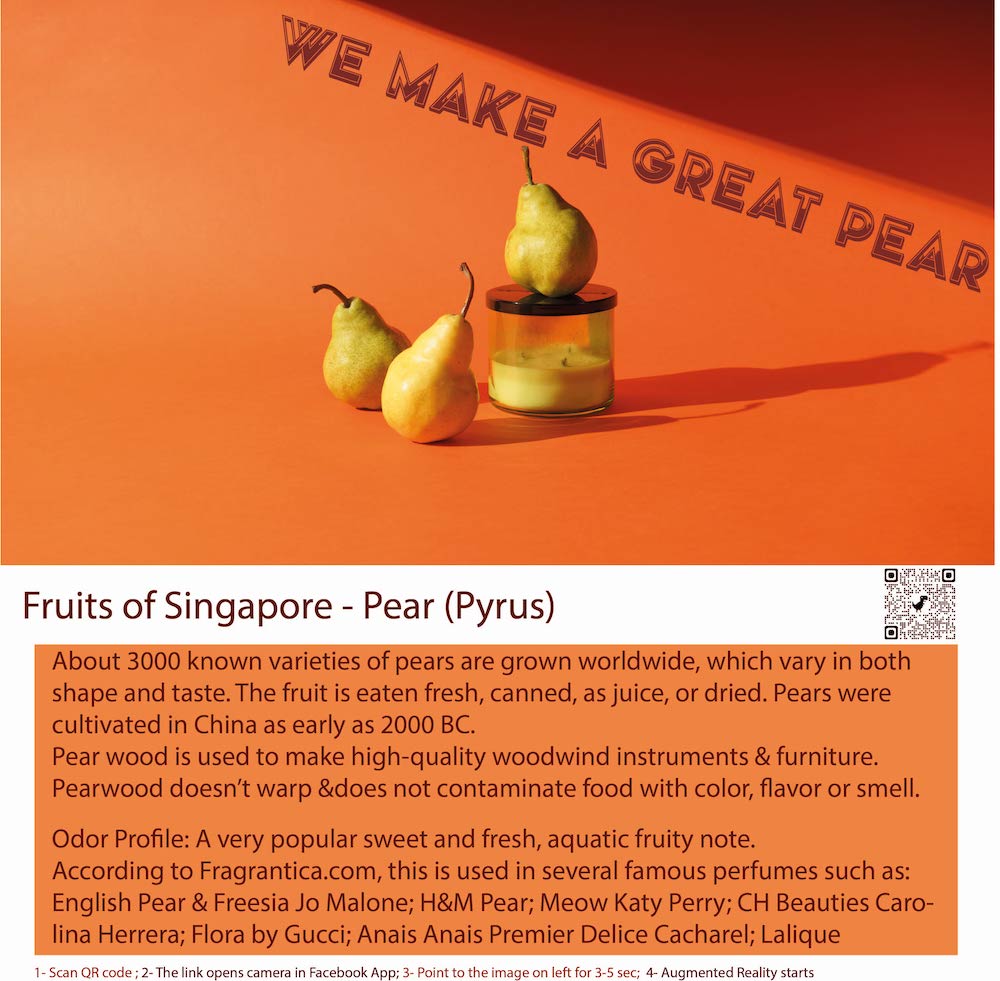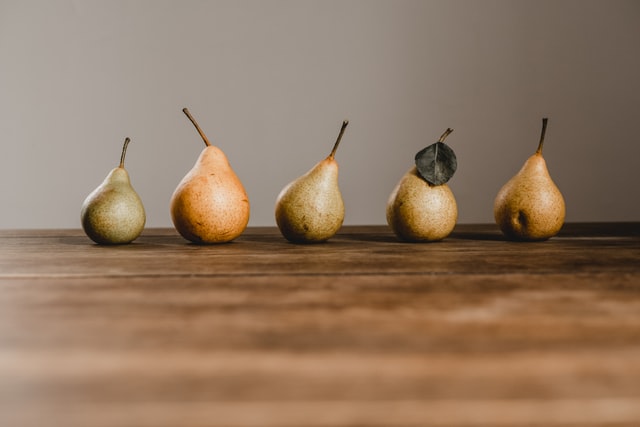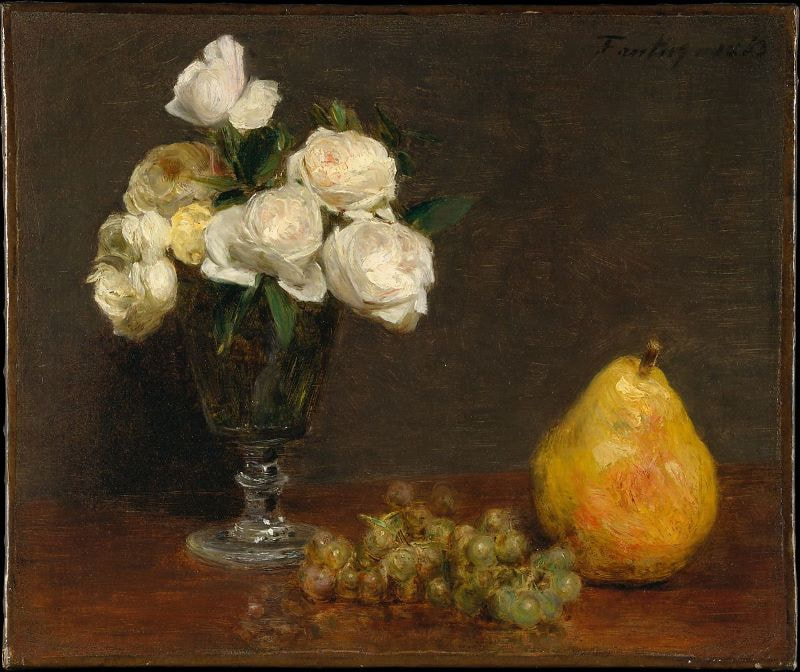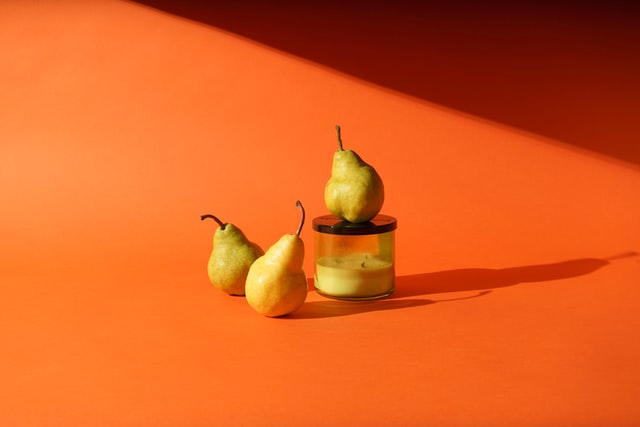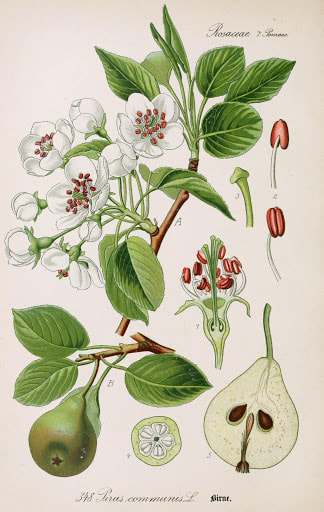Pear Fragrance Notes: A Delicate and Captivating Essence
The Allure of Pear: A Fragrant and Versatile Fruit
Pear, a delectable and aromatic fruit, has captured the hearts of people worldwide for its sweet and refreshing flavor, as well as its delightful fragrance. This essay explores the various facets of pear, from its use in perfumes and fragrances to therapeutic oils, its culinary applications, medicinal uses, historical significance, and some fun and crazy facts that make it a fascinating fruit.
Fragrance and Perfumes: The essence of ripe pear emits a luscious and delicate fragrance that exudes elegance and sophistication. Perfumers often incorporate pear notes in their creations to add a fruity, fresh, and youthful touch to fragrances. The sweet and crisp aroma of pear brings a sense of nature's bounty to perfumes, making them popular choices, especially during spring and summer seasons.
Therapeutic Properties of Pear Oil: Pear essential oil is derived from the fruit's peel and seeds and is known for its therapeutic properties. It is often used in aromatherapy to promote relaxation, reduce stress, and uplift the mood. Pear oil is believed to have calming effects, making it beneficial in stress-relief blends and massage oils.
Culinary Delights and Nutritional Benefits: Pears are cherished for their juicy and succulent flesh, making them a delightful addition to various culinary creations. From fresh fruit salads to poached pears, pear tarts, and compotes, the fruit lends a unique and delicate flavor to both sweet and savory dishes. Rich in dietary fiber, vitamins C and K, and antioxidants, pears contribute to a healthy and well-balanced diet.
Medicinal Uses in Traditional Medicine: In traditional medicine systems, various parts of the pear tree are utilized for their medicinal properties. Pear leaves are believed to have anti-inflammatory and diuretic properties and are used in herbal remedies for managing urinary tract issues. Pear juice is also used as a mild laxative to aid digestion and alleviate constipation.
Historical Significance and Cultural Relevance: Pears have a rich history dating back to ancient times. The fruit is believed to have originated in the region encompassing Western Asia and Europe. In ancient Greek and Roman cultures, pears symbolized love and fertility and were often offered as gifts to express affection. Throughout history, the pear has been cultivated and celebrated in various cultures, becoming a symbol of prosperity and hospitality.
Fun and Crazy Facts:
Pear, with its captivating fragrance, delectable taste, and therapeutic properties, has earned its place as a cherished and versatile fruit. From its enchanting use in perfumes and fragrances to its contribution to culinary delights and traditional medicine, the pear continues to be a symbol of love, hospitality, and prosperity. Its historical significance and fun facts add to its allure, making the pear an enchanting and cherished fruit that delights the senses and nourishes the soul.
Pear, a delectable and aromatic fruit, has captured the hearts of people worldwide for its sweet and refreshing flavor, as well as its delightful fragrance. This essay explores the various facets of pear, from its use in perfumes and fragrances to therapeutic oils, its culinary applications, medicinal uses, historical significance, and some fun and crazy facts that make it a fascinating fruit.
Fragrance and Perfumes: The essence of ripe pear emits a luscious and delicate fragrance that exudes elegance and sophistication. Perfumers often incorporate pear notes in their creations to add a fruity, fresh, and youthful touch to fragrances. The sweet and crisp aroma of pear brings a sense of nature's bounty to perfumes, making them popular choices, especially during spring and summer seasons.
Therapeutic Properties of Pear Oil: Pear essential oil is derived from the fruit's peel and seeds and is known for its therapeutic properties. It is often used in aromatherapy to promote relaxation, reduce stress, and uplift the mood. Pear oil is believed to have calming effects, making it beneficial in stress-relief blends and massage oils.
Culinary Delights and Nutritional Benefits: Pears are cherished for their juicy and succulent flesh, making them a delightful addition to various culinary creations. From fresh fruit salads to poached pears, pear tarts, and compotes, the fruit lends a unique and delicate flavor to both sweet and savory dishes. Rich in dietary fiber, vitamins C and K, and antioxidants, pears contribute to a healthy and well-balanced diet.
Medicinal Uses in Traditional Medicine: In traditional medicine systems, various parts of the pear tree are utilized for their medicinal properties. Pear leaves are believed to have anti-inflammatory and diuretic properties and are used in herbal remedies for managing urinary tract issues. Pear juice is also used as a mild laxative to aid digestion and alleviate constipation.
Historical Significance and Cultural Relevance: Pears have a rich history dating back to ancient times. The fruit is believed to have originated in the region encompassing Western Asia and Europe. In ancient Greek and Roman cultures, pears symbolized love and fertility and were often offered as gifts to express affection. Throughout history, the pear has been cultivated and celebrated in various cultures, becoming a symbol of prosperity and hospitality.
Fun and Crazy Facts:
- The world's oldest known pear tree, known as "The Endicott Pear Tree," is located in Danvers, Massachusetts, and is estimated to be over 380 years old.
- There are over 3,000 pear varieties worldwide, ranging in flavors and appearances, from sweet and juicy to crisp and firm.
- Pears are a member of the rose family (Rosaceae), making them relatives of apples and roses.
Pear, with its captivating fragrance, delectable taste, and therapeutic properties, has earned its place as a cherished and versatile fruit. From its enchanting use in perfumes and fragrances to its contribution to culinary delights and traditional medicine, the pear continues to be a symbol of love, hospitality, and prosperity. Its historical significance and fun facts add to its allure, making the pear an enchanting and cherished fruit that delights the senses and nourishes the soul.
To experience augmented reality, please open the Facebook-app using QR code and point to the image below
Scent Crafting: From Orchard to Perfume Bottle
A pear is a type of fruit that is typically round or bell-shaped and has a thin skin that can range in color from green to yellow to red. Pears are often eaten fresh, but can also be canned, frozen, or dried. They are a good source of fiber and Vitamin C. Pears are also used in cooking and baking, they can be added to salads, used in sauces and jams, poached and grilled. They are considered a low-calorie fruit, which makes them a popular choice for people trying to maintain a healthy diet. Pears are generally harvested in late summer or early fall, depending on the variety.
Pear fruit is consumed worldwide and pear wood is one of the preferred materials in the manufacture of high-quality woodwind instruments. The tree is medium-sized and native to coastal and mildly temperate regions of Europe, North Africa, and Asia.
About 3000 known varieties of pears are grown worldwide, which vary in both shape and taste. The fruit is available for consumption fresh, canned, as juice, or dried.
The pear industry in Singapore has a long history, dating back to the early 20th century. Pears were first introduced to the island by European traders and colonizers, and were primarily grown in the Kranji and Lim Chu Kang areas. The industry thrived in the early 20th century, but declined due to a lack of investment and competition from other fruit crops. In recent years, there has been a resurgence of interest in pear cultivation in Singapore, with several local farmers and organizations working to revive the industry.
Pears are used in various ways in Asian cuisine. In China, they are often consumed as a fresh fruit, but they are also used in traditional Chinese medicine to treat a variety of ailments. In Korea, pears are often used to make a sweet and refreshing beverage called "bae-sul," which is made by mixing pear juice with honey and ginger. In Japan, pears are used to make a type of brandy called "nashi-shu," and they are also used in confectionery and traditional sweets. In Vietnam, pears are used to make a sweet, sticky and savory dish called "bánh đa nem" which is a fried spring roll wrapper filled with pear, meat or shrimp and vermicelli. Pears can also be poached in syrup, added to salads and used in desserts.
Pear fruit is consumed worldwide and pear wood is one of the preferred materials in the manufacture of high-quality woodwind instruments. The tree is medium-sized and native to coastal and mildly temperate regions of Europe, North Africa, and Asia.
About 3000 known varieties of pears are grown worldwide, which vary in both shape and taste. The fruit is available for consumption fresh, canned, as juice, or dried.
The pear industry in Singapore has a long history, dating back to the early 20th century. Pears were first introduced to the island by European traders and colonizers, and were primarily grown in the Kranji and Lim Chu Kang areas. The industry thrived in the early 20th century, but declined due to a lack of investment and competition from other fruit crops. In recent years, there has been a resurgence of interest in pear cultivation in Singapore, with several local farmers and organizations working to revive the industry.
Pears are used in various ways in Asian cuisine. In China, they are often consumed as a fresh fruit, but they are also used in traditional Chinese medicine to treat a variety of ailments. In Korea, pears are often used to make a sweet and refreshing beverage called "bae-sul," which is made by mixing pear juice with honey and ginger. In Japan, pears are used to make a type of brandy called "nashi-shu," and they are also used in confectionery and traditional sweets. In Vietnam, pears are used to make a sweet, sticky and savory dish called "bánh đa nem" which is a fried spring roll wrapper filled with pear, meat or shrimp and vermicelli. Pears can also be poached in syrup, added to salads and used in desserts.
The Role of Pear in Perfume Ingredient Selection
Pear grows in cool, temperate climate. It has been used as a food since prehistoric times. Many traces have been found in prehistoric pile dwellings around Lake Zurich.
Pears cultivation began in in China as early as 2000 BC. The pear was also cultivated by the Romans, who ate the fruits raw or cooked, just like apples.
Pears have been used in traditional Asian medicine for centuries as a therapeutic food to treat a variety of ailments.
In traditional Chinese medicine (TCM), pears are considered to have a "cooling" effect on the body and are believed to help clear heat and toxins from the lungs and throat. They are often used to treat coughs, sore throats, and other respiratory issues. Pears are also believed to help moisturize the skin, improve digestion and reduce inflammation.
In Korean medicine, pears are believed to help nourish the lungs and relieve coughing.
In Japan, pears are believed to help moisturize the skin and prevent wrinkles, as well as to help lower cholesterol levels.
In Vietnam, pears are considered to have a "cooling" and "moistening" effect on the body and are believed to help relieve constipation and improve digestion.
It's worth noting that while traditional uses of pear in Asian medicine are well established, there is a lack of scientific evidence to back up many of these claims. It is always best to consult with a qualified healthcare professional before using any fruit or food as medicine.
Pears cultivation began in in China as early as 2000 BC. The pear was also cultivated by the Romans, who ate the fruits raw or cooked, just like apples.
Pears have been used in traditional Asian medicine for centuries as a therapeutic food to treat a variety of ailments.
In traditional Chinese medicine (TCM), pears are considered to have a "cooling" effect on the body and are believed to help clear heat and toxins from the lungs and throat. They are often used to treat coughs, sore throats, and other respiratory issues. Pears are also believed to help moisturize the skin, improve digestion and reduce inflammation.
In Korean medicine, pears are believed to help nourish the lungs and relieve coughing.
In Japan, pears are believed to help moisturize the skin and prevent wrinkles, as well as to help lower cholesterol levels.
In Vietnam, pears are considered to have a "cooling" and "moistening" effect on the body and are believed to help relieve constipation and improve digestion.
It's worth noting that while traditional uses of pear in Asian medicine are well established, there is a lack of scientific evidence to back up many of these claims. It is always best to consult with a qualified healthcare professional before using any fruit or food as medicine.
Unveiling the Aromatics of Fresh Pears
Pear has been subject of hundreds and thousands of still life paintings. Paul Cézanne regularly painted pears, which was one of his favorite subject. He is one of the great Post-Impressionist painters of the 19th century, renowned for his radiant landscapes, intense portraits, and complex still lifes.
Here are a few fun facts about pears:
Here are a few fun facts about pears:
- Pears are a member of the rose family, Rosaceae, and are closely related to apples.
- The pear is one of the oldest cultivated fruits in the world, dating back to ancient times. The ancient Egyptians, Greeks, and Romans all cultivated pears.
- The word "pear" comes from the Old English word "pear" which means "a fruit."
- There are over 3,000 varieties of pears grown worldwide, but the most commonly grown varieties in the United States are Bartlett, Bosc, and Anjou.
- Pears are a good source of fiber, vitamin C, and potassium.
- Pears are a fruit that ripen from the inside out. A pear that is picked when it is mature will ripen in a few days at room temperature.
- Pears are not only eaten as fresh fruit but also used in cooking and baking. They can be used to make jams, jellies, pies, and tarts.
- Pear wood is highly valued for its beautiful grain, and it is often used to make furniture and musical instruments.
- In medieval times, it was customary to give a pear tree as a wedding gift. It was said that the tree would bear fruit in the first year of the couple's marriage and the number of fruits would correspond to the number of children they would have.
- Pears are also used in various types of brandy and liqueurs, such as Poire Williams, which is made with Williams pear, and Calvados, which is made with apples and pears.
- Asian pears were cultivated in China as early as 1134 B.C.
- The Chinese considered the pear, which they call “li,” to be a symbol of immortality. The destruction of a pear tree symbolized tragic or untimely death.
- Before tobacco was introduced in Europe, pear leaves were smoked.
- Pears were used as a natural remedy against nausea in ancient Greece.
Pear's Contribution to Perfume Complexity
In perfumery, pear is often used as a top note to add a fresh, fruity, and sweet aroma to a fragrance. The aroma profile of pear in perfumery is described as being green, juicy, and slightly floral. It is a versatile note that can be used in a variety of fragrance types such as floral, fruity, and gourmand. Some perfumes that feature a pear note include Jo Malone Peony & Blush Suede and Moschino Funny. It can also be combined with other fruits, florals or spices to create complex and interesting fragrance compositions
Pear note is also used in many other perfumery applications such as air fresheners, laundry detergents, fabric softeners and personal care products.
The aroma profile of pear can be achieved through the use of several different chemicals in perfumery. Some of the chemicals that are commonly used to create a pear aroma include:
Pear note is also used in many other perfumery applications such as air fresheners, laundry detergents, fabric softeners and personal care products.
The aroma profile of pear can be achieved through the use of several different chemicals in perfumery. Some of the chemicals that are commonly used to create a pear aroma include:
- Ethyl lactate: This chemical has a fruity, sweet aroma that is similar to the scent of ripe pears. It is often used as a top note in pear-scented fragrances.
- Methyl cyclopentenolone: This chemical has a sweet, fruity, and floral aroma that is similar to the scent of pears. It is often used as a middle note in pear-scented fragrances.
- Ethyl 2-methylbutyrate: This chemical has a fruity, sweet, and slightly floral aroma that is similar to the scent of pears. It is often used as a middle note in pear-scented fragrances.
- Isobutyl butyrate: This chemical has a fruity, sweet aroma that is similar to the scent of pears. It is often used as a middle note in pear-scented fragrances.
- Ethyl butyrate: This chemical has a fruity, sweet aroma that is similar to the scent of ripe pears. It is often used as a top note in pear-scented fragrances.
Exploring Pear-Based Fragrance Families
Pear health benefits:
1- Highly nutritious - It has Vitamin C: 12% of the Daily Value (DV) ; Vitamin K: 6% of DV; Potassium: 4% of the DV; Copper: 16% of DV and also provides small amounts of folate, provitamin A, and niacin. Folate and niacin are important for cellular function and energy production, while provitamin A supports skin health and wound healing
2- Good for gut health - It usually offers 22% of your daily fiber needs
3- Other compounds - Anthocyanin-rich foods like pear and berries is associated with a reduced risk of heart disease
4- Anti-inflammatory properties- Pears pack several vitamins and minerals, such as copper and vitamins C and K, which also combat inflammation
5- May have anticancer effects- Their anthocyanin and cinnamic acid contents have been shown to fight cancer
6- Lower risk of diabetes- One study in over 200,000 people found that eating 5 or more weekly servings of anthocyanin-rich fruits like red pears was associated with a 23% lower risk of type 2 diabetes
7- May be good for heart- Their procyanidin antioxidants may decrease stiffness in heart tissue, lower LDL (bad) cholesterol, and increase HDL (good) cholesterol. Furthermore, regular intake of pears and other white-fleshed fruits is thought to lower stroke risk. One 10-year study in over 20,000 people determined that every 25 grams of white-fleshed fruit eaten daily decreased stroke risk by 9%
1- Highly nutritious - It has Vitamin C: 12% of the Daily Value (DV) ; Vitamin K: 6% of DV; Potassium: 4% of the DV; Copper: 16% of DV and also provides small amounts of folate, provitamin A, and niacin. Folate and niacin are important for cellular function and energy production, while provitamin A supports skin health and wound healing
2- Good for gut health - It usually offers 22% of your daily fiber needs
3- Other compounds - Anthocyanin-rich foods like pear and berries is associated with a reduced risk of heart disease
4- Anti-inflammatory properties- Pears pack several vitamins and minerals, such as copper and vitamins C and K, which also combat inflammation
5- May have anticancer effects- Their anthocyanin and cinnamic acid contents have been shown to fight cancer
6- Lower risk of diabetes- One study in over 200,000 people found that eating 5 or more weekly servings of anthocyanin-rich fruits like red pears was associated with a 23% lower risk of type 2 diabetes
7- May be good for heart- Their procyanidin antioxidants may decrease stiffness in heart tissue, lower LDL (bad) cholesterol, and increase HDL (good) cholesterol. Furthermore, regular intake of pears and other white-fleshed fruits is thought to lower stroke risk. One 10-year study in over 20,000 people determined that every 25 grams of white-fleshed fruit eaten daily decreased stroke risk by 9%
Creating Seasonal and Timeless Pear Fragrances
There are many famous brand perfumes that feature pear notes as part of their fragrance composition. Some of these include:
- Jo Malone Peony & Blush Suede: This is a floral, fruity fragrance that features a pear note as a top note, along with peony and suede.
- Moschino Funny: This is a floral, fruity fragrance that features a pear note as a top note, along with notes of mandarin, bergamot, and freesia.
- Marc Jacobs Daisy Dream: This is a floral, fruity fragrance that features a pear note as a top note, along with notes of blackberry, jasmine, and blue wisteria.
- Burberry Brit Rhythm: This is a floral, fruity fragrance that features a pear note as a top note, along with notes of lavender and tonka bean.
- Gucci Flora: This is a floral, fruity fragrance that features a pear note as a top note, along with notes of peony, rose, and patchouli.
- Dior J'adore L'Absolu: This is a floral, fruity fragrance that features a pear note as a top note, along with notes of jasmine, rose, and vanilla.
Join Scentopia, Sentosa's latest tourist attraction wonderful orchid scent crafting, fragrance tour, bridal shower or corporate team building which includes perfume making onsite and offsite, beach activities and more. We also serve primary school learning journey, secondary students and pupil on industrial excursions. Know more about our orchids perfume bar or therapeutic orchid scents and other wellness aromas. Conatct Perfume workshop or book a scent crafting session here.

